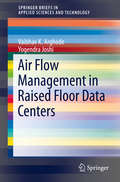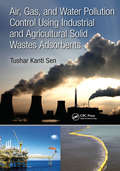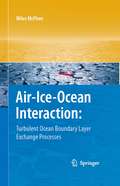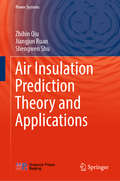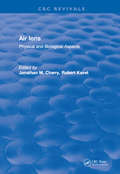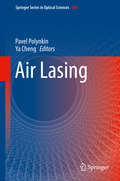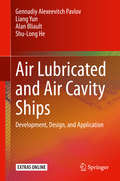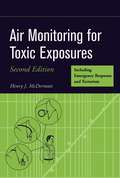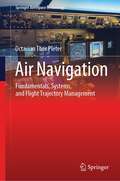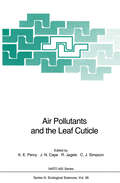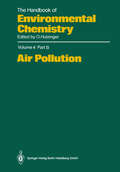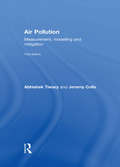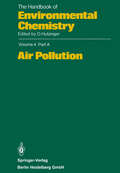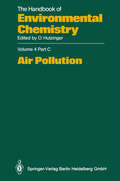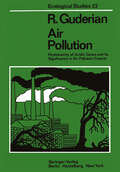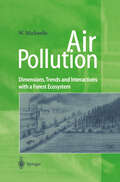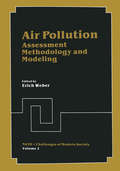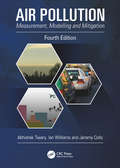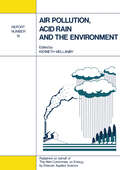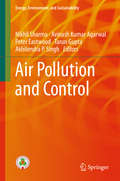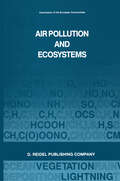- Table View
- List View
Air Flow Management in Raised Floor Data Centers (SpringerBriefs in Applied Sciences and Technology)
by Vaibhav K. Arghode Yogendra JoshiThe Brief discuss primarily two aspects of air flow management in raised floor data centers. Firstly, cooling air delivery through perforated tiles will be examined and influence of the tile geometry on flow field development and hot air entrainment above perforated tiles will be discussed. Secondly, the use of cold aisle containment to physically separate hot and cold regions, and minimize hot and cold air mixing will be presented. Both experimental investigations and computational efforts are discussed and development of computational fluid dynamics (CFD) based models for simulating air flow in data centers is included. In addition, metrology tools for facility scale air velocity and temperature measurement, and air flow rate measurement through perforated floor tiles and server racks are examined and the authors present thermodynamics-based models to gauge the effectiveness and importance of air flow management schemes in data centers.
Air, Gas, and Water Pollution Control Using Industrial and Agricultural Solid Wastes Adsorbents
by Tushar Kanti SenAir and water pollution occurs when toxic pollutants of varying kinds (organic, inorganic, radioactive and so on) are directly or indirectly discharged into the environment without adequate treatment to remove these potential pollutants. There are a total of 13 book chapters in three sections contributed by significant number of expert authors around the world, aiming to provide scientific knowledge and up-to-date development of various solid wastes based cost-effective adsorbent materials and its sustainable application in the removal of contaminates/pollutants from air, gas and water. This book is useful for the professions, practicing engineers, scientists, researchers, academics and undergraduate and post-graduate students’ interest on this specific area. Key Features: • Exclusive compilation of information on use of industrial and agricultural waste based adsorbents for air and water pollution abatement. • Explores utilization of industrial solid wastes in adsorptive purification and agricultural and agricultural by-products in separation and purification. • Discusses cost-effective solid wastes based emerging adsorbents. • Alternative adsorbents in the removal of a wide range of contaminants and pollutants from water is proposed. • Includes performance of unit operations in waste effluents treatment.
Air, Gas, and Water Pollution Control Using Industrial and Agricultural Solid Wastes Adsorbents
by Tushar Kanti SenAir and water pollution occurs when toxic pollutants of varying kinds (organic, inorganic, radioactive and so on) are directly or indirectly discharged into the environment without adequate treatment to remove these potential pollutants. There are a total of 13 book chapters in three sections contributed by significant number of expert authors around the world, aiming to provide scientific knowledge and up-to-date development of various solid wastes based cost-effective adsorbent materials and its sustainable application in the removal of contaminates/pollutants from air, gas and water. This book is useful for the professions, practicing engineers, scientists, researchers, academics and undergraduate and post-graduate students’ interest on this specific area. Key Features: • Exclusive compilation of information on use of industrial and agricultural waste based adsorbents for air and water pollution abatement. • Explores utilization of industrial solid wastes in adsorptive purification and agricultural and agricultural by-products in separation and purification. • Discusses cost-effective solid wastes based emerging adsorbents. • Alternative adsorbents in the removal of a wide range of contaminants and pollutants from water is proposed. • Includes performance of unit operations in waste effluents treatment.
Air-Ice-Ocean Interaction: Turbulent Ocean Boundary Layer Exchange Processes
by Miles McPheeAt a time when the polar regions are undergoing rapid and unprecedented change, understanding exchanges of momentum, heat and salt at the ice-ocean interface is critical for realistically predicting the future state of sea ice. By offering a measurement platform largely unaffected by surface waves, drifting sea ice provides a unique laboratory for studying aspects of geophysical boundary layer flows that are extremely difficult to measure elsewhere. This book draws on both extensive observations and theoretical principles to develop a concise description of the impact of stress, rotation, and buoyancy on the turbulence scales that control exchanges between the atmosphere and underlying ocean when sea ice is present. Several interesting and unique observational data sets are used to illustrate different aspects of ice-ocean interaction ranging from the impact of salt on melting in the Greenland Sea marginal ice zone, to how nonlinearities in the equation of state for seawater affect mixing in the Weddell Sea. The book’s content, developed from a series of lectures, may be appropriate additional material for upper-level undergraduates and first-year graduate students studying the geophysics of sea ice and planetary boundary layers.
Air Insulation Prediction Theory and Applications (Power Systems)
by Zhibin Qiu Jiangjun Ruan Shengwen ShuThis book proposes the air insulation prediction theory and method in the subject of electrical engineering. Prediction of discharge voltage in different cases are discussed and worked out by simulation. After decades, now bottlenecks of traditional air discharge theories can be solved with this book. Engineering applications of the theory in air gap discharge voltage prediction are introduced. This book serves as reference for graduate students, scientific research personnel and engineering staff in the related fields.
Air Ions: Physical and Biological Aspects
by Jonathan M. CharryAir Ions: Physical and Biological Aspects fully develops two areas that are important for a comprehensive understanding of the subject of air ions: (1) the physical/chemical nature of ions, and (2) their potential interaction with biological systems. The reader is led through a series of none chapter, the first five of which lay the basis for understanding ions in the context of naturally and artificially created environments. The final four chapters are well situated to discuss the literature and history connected with the search for ion-induced biological effects.
Air Ions: Physical and Biological Aspects
by Jonathan M. CharryAir Ions: Physical and Biological Aspects fully develops two areas that are important for a comprehensive understanding of the subject of air ions: (1) the physical/chemical nature of ions, and (2) their potential interaction with biological systems. The reader is led through a series of none chapter, the first five of which lay the basis for understanding ions in the context of naturally and artificially created environments. The final four chapters are well situated to discuss the literature and history connected with the search for ion-induced biological effects.
Air Lasing (Springer Series in Optical Sciences #208)
by Pavel Polynkin Ya ChengThis book presents the first comprehensive, interdisciplinary review of the rapidly developing field of air lasing. In most applications of lasers, such as cutting and engraving, the laser source is brought to the point of service where the laser beam is needed to perform its function. However, in some important applications such as remote atmospheric sensing, placing the laser at a convenient location is not an option. Current sensing schemes rely on the detection of weak backscattering of ground-based, forward-propagating optical probes, and possess limited sensitivity. The concept of air lasing (or atmospheric lasing) relies on the idea that the constituents of the air itself can be used as an active laser medium, creating a backward-propagating, impulsive, laser-like radiation emanating from a remote location in the atmosphere. This book provides important insights into the current state of development of air lasing and its applications.
Air Lubricated and Air Cavity Ships: Development, Design, and Application
by Alan Bliault Liang Yun Gennadiy Alexeevitch Pavlov Shu-Long HeAir Lubrication and Air Cavity Technology is a major development that has emerged in recent years as a means to reduce resistance and powering for many types of ships, and an efficient design for high speed marine vessels. This book introduces the mechanisms for boundary layer drag reduction and concepts studied in early research work. Air bubble and sheet lubrication for displacement vessels is outlined and the key projects introduced. Generation of low volume flow air cavities under the hull of displacement, semi displacement and planing vessels are introduced together with theoretical and empirical analysis and design methods. Resistance reduction, power reduction and fuel efficiency are covered for both displacement and high speed vessels. Air layer and air cavity effects on vessel static and dynamic stability are covered, linked to regulatory requirements such as IMO. Seaway motions and reduced impact load of high speed craft in waves are discussed including model test results. Integration of propulsion systems for optimum powering is summarized. A design proposal for a wave piercing air cavity craft is included in an appendix. A comprehensive listing of document resources and internet locations is provided for further research.
Air Monitoring for Toxic Exposures
by Henry J. McDermottGet the Latest from the Field This book offers ready-to-use information for measuring a wide variety of airborne hazardous materials including chemicals, radon, and bioaerosols. It provides the latest procedures for air sampling, collecting biological and bulk samples, evaluating dermal exposures, and determining the advantages and limitations of a given air monitoring method.
Air Navigation: Fundamentals, Systems, and Flight Trajectory Management (Springer Aerospace Technology)
by Octavian Thor PleterThis book takes a new approach to air navigation, extending the classic scope of positioning and guidance to efficient and safe 4D flight trajectory management. Modern air navigation aims at flight trajectories optimisation. There is an infinite number of solutions to the classic navigation problem of flying from one airport to another, but most of them are wasteful of resources and even risky. Minimising all costs and risks incurred by the 4D flight trajectory makes air navigation both efficient and safe, which are key factors in air navigation services. Beyond minimising fuel burn and CO2, efficiency addresses non-CO2 emissions and noise. This is a visually intensive book, using examples and case studies to illustrate the concepts, the physics of navigation and the mathematical models involved. Numerical examples reflect its problem-solving nature. It is useful to aerospace students, engineers, pilots, air traffic controllers, technicians, and scientists curious about aviation.
Air Pollutants and the Leaf Cuticle (Nato ASI Subseries G: #36)
by Kevin E. Percy J. Neil Cape Richard Jagels Caroline J. SimpsonPlant leaves are covered by a thin, lipoidal, non-living membrane called the cuticle. Forming the interface between plants and the atmospheric environment, it presents an effective barrier to pollutant entry. The book provides a comprehensive review of air pollutant effects on the cuticle and covers the following thematic areas: - Cuticular physicochemical characteristics, physiological, regulatory, and protective roles. - Effects, mechanisms, and consequences of air pollutant interaction with leaf cuticles. - Non-anthropogenic and environmental influences on the cuticle and potential of the cuticle for biomonitoring and critical levels mapping. - New developments in experimental methodology and analytical techniques.
Air Pollution (The Handbook of Environmental Chemistry #4 / 4B)
by H. Brauer J. S. Gaffney R. Harkov M.A.K. Khalil F. W. Lipfert N. A. Marley E. W. Prestbo G. E. ShawAn important purpose of The Handbook of Environmental Chemistry is to aid the understanding of distribution and chemical reaction processes which occur in the environment. Volume 4, Part B of this series is dedicated to Air Pollution Control Equipment, Materials Damage, Peroxyacyl Nitrates, Semivolatile Compounds in the Atmosphere, and Arctic Haze.
Air Pollution: Measurement, Modelling and Mitigation, Third Edition
by Jeremy Colls Abhishek TiwaryA one stop, comprehensive textbook, covering the three essential components of air pollution science. The Third Edition has been updated with the latest developments, especially the inclusion of new information on the role of air pollutants in climate change. The authors give greater coverage to the developing economies around the world where air pollution problems are on the rise. The Third Edition continues to cover a wide range of air quality issues, retaining a quantitative perspective. Topics covered include - gaseous and particulate air pollutants, measurement techniques, meteorology and dispersion modelling, mobile sources, indoor air, effects on plants, materials, humans and animals. Moving away from classical toxic air pollutants, there is a chapter on climate change and another on the depletion of stratospheric ozone. A special feature of this new edition is the inclusion of a fresh chapter on air pollution mitigation by vegetation, mainly its role in maintaining a sustainable urban environment. Recommended for upper-level undergraduate and postgraduate courses specialising in air pollution, both for environmental scientists and engineers. The new material included in the Third Edition extends its use by practitioners in consultancies or local authorities.
Air Pollution: Measurement, Modelling and Mitigation, Third Edition
by Jeremy Colls Abhishek TiwaryA one stop, comprehensive textbook, covering the three essential components of air pollution science. The Third Edition has been updated with the latest developments, especially the inclusion of new information on the role of air pollutants in climate change. The authors give greater coverage to the developing economies around the world where air pollution problems are on the rise. The Third Edition continues to cover a wide range of air quality issues, retaining a quantitative perspective. Topics covered include - gaseous and particulate air pollutants, measurement techniques, meteorology and dispersion modelling, mobile sources, indoor air, effects on plants, materials, humans and animals. Moving away from classical toxic air pollutants, there is a chapter on climate change and another on the depletion of stratospheric ozone. A special feature of this new edition is the inclusion of a fresh chapter on air pollution mitigation by vegetation, mainly its role in maintaining a sustainable urban environment. Recommended for upper-level undergraduate and postgraduate courses specialising in air pollution, both for environmental scientists and engineers. The new material included in the Third Edition extends its use by practitioners in consultancies or local authorities.
Air Pollution (The Handbook of Environmental Chemistry #4 / 4A)
by H. Van Dop P. Fabian H. Güsten J. M. Hales A. WintEnvironmental Chemistry is a relatively young science. Interest in this subject, however, is growing very rapidly and, although no agreement has been reached as yet about the exact content and limits of this interdisciplinary discipline, there appears to be increasing interest in seeing environmental topics which are based on chemistry embodied in this subject. One of the first objectives of Environmental Chemistry must be the study of the environment and of natural chemical processes which occur in the environment. A major purpose of this series on Environmental Chemistry, therefore, is to present a reasonably uniform view of various aspects of the chemistry of the environment and chemical reactions occurring in the environment. The industrial activities of man have given a new dimension to Environmental Chemistry. We have now synthesized and described over five million chemical compounds and chemical industry produces about hundred and fifty million tons of synthetic chemicals annually. We ship billions of tons of oil per year and through mining operations and other geophysical modifications, large quantities of inorganic and organic materials are released from their natural deposits. Cities and metropolitan areas of up to 15 million inhabitants produce large quantities of waste in relatively small and confined areas. Much of the chemical products and waste products of modern society are released into the environment either during production, storage, transport, use or ultimate disposal. These released materials participate in natural cycles and reactions and frequently lead to interference and disturbance of natural systems.
Air Pollution (The Handbook of Environmental Chemistry #4 / 4C)
by C. Gries F. Lipfert M. Lippmann T. H. NashEnvironmental Chemistry is a relatively young science. Interest in this subject, however, is growing very rapidly and, although no agreement has been reached as yet about the exact content and limits of this interdisciplinary subject, there appears to be increasing interest in seeing environmental topics which are based on chemistry embodied in this subject. One of the first objectives of Environmental Chemistry must be the study of the environment and of natural chemical processes which occur in the environment. A major purpose of this series on Environmental Chemistry, therefore, is to present a reasonably uniform view of various aspects of the chemistry of the environment and chemical reactions occurring in the environment. The industrial activities of man have given a new dimension to Environmental Chemistry. We have now synthesized and described over five million chemical compounds and chemical industry produces about one hundred and fifty million tons of synthetic chemicals annually. We ship billions of tons of oil per year and through mining operations and other geophysical modifications, large quantities of inorganic and organic materials are released from their natural deposits. Cities and metropolitan areas of up to 15 million inhabitants produce large quantities of waste in relatively small and confined areas. Much of the chemical products and waste products of modern society are released into the environment either during production, storage, transport, use or ultimate disposal. These released materials participate in natural cycles and reactions and frequently lead to interference and disturbance of natural systems.
Air Pollution: Phytotoxicity of Acidic Gases and Its Significance in Air Pollution Control (Ecological Studies #22)
by R. GuderianEmissions of gaseous air pollutants have increased in the last years in spite of increased controls and concern for air quality. Predictions of future development also indicate that a further increase in emissions must be expected. From an extensive analysis of fuel use in conventional power plants in industry and for domestic heating, Brocke and Schade (1971) and Schade (1975) predict that sulfur dioxide (S02) emissions in the Federal Republic of Germany will increase from '3. 5 million t in 1969, over 4. 2 million t in 1973, to 4. 6 million t in 1980. Rasch (1971) predicts that emission of hydrogen chloride (HCI) from burning of wastes will increase from a present 8000 t/year to about 100000 t in 1980. Emission of gaseous fluoride compounds, in North Rhine Westphalia alone, are expected to increase from 7500 t in 1969 to 8800 t in 1985 (MAGS, 1972). Similar predic tions have also been made in the USA (Heggestadt and Heck, 1971). A doubling of S02 emissions from oil and particularly coal-fired power plants is expected between 1960 and 1980 (Wood, 1968; Lewis et aI. , 1974). When it is considered that total control of air pollutants is technically and especially economically impossible, it is important that, in the future, emissions are controlled within a technical and economic framework to such an extent that ambient pollutant concentrations near the ground present no hazard to man or his environment (BImSchG, 1974).
Air Pollution: Dimensions, Trends and Interactions with a Forest Ecosystem
by Walfried MichaelisIn the early 1980s, forest decline became a matter of public and scientific concern when forest stands with Norway spruce (Picea abies [L. ] Karst. ) showed evident damage on a large geographical scale throughout Europe. The causes of the observed symptoms could not be elucidated on the basis of the state of knowledge at that time. Therefore, several research projects were launched both in Germany and in some other countries in order to identify the relevant pathogenic factors. In 1985, the Federal Ministry for Research and Technology decided to include the site "Postturm", forest district Farchau/Ratzeburg, in the spon sorship of the research on forest decline as a site typical for lowlands and a sphere of anthropogenic urban influence. The investigation area is situated about 40 krn east-northeast of the city of Hamburg. Since spruce trees in particular showed severe decline, emphasis was laid on this species. The programme started in 1986 and extended to 1992, with some activities con tinuing beyond this time. Working groups from 13 institutions took part in the overall project.
Air Pollution: Assessment Methodology and Modeling (Nato Challenges of Modern Society #2)
by Erich WeberThe North Atlantic Treaty Organization (NATO) established the "Committee on the Challenges of Modern Society" (CCMS) at the November 1969 meeting of the North Atlantic Council. The CCMS was charged with developing meaningful environmen tal and social programs that complement other international pro grams, and with showing leadership, first, in solution of exist ing problems and, second, in development of long-range goals for environmental protection in the NATO sphere of influence and in other countries as well. A first Pilot Study on Air Pollution was initiated by the CCMS at its inaugural meeting in December 1969. The United States (Environmental Protection Agency) has been the pilot nation with the Federal Republic of Germany (Federal Minis try of the Interior) and Turkey (Scientific and Technical Rese arch Council) as co-pilot nations. The Pilot Study on Air Pollution was an action program de signed to demonstrate and encourage the utilization of existing knowledge for the development of air quality management programs. It entailed the demonstration of a systems approach to air quali ty management. Case studies have been carried out in Ankara, Turkey; Frankfurt, Federal Republic of Germany; St. Louis, U.S.; Oslo, Norway; and South Holland Region, The Netherlands (NATO/CCMS Report No. 6, Appendices A- E).
Air Pollution: Measurement, Modelling and Mitigation, Fourth Edition
by Ian Williams Abhishek TiwaryThis established textbook offers a one-stop, comprehensive coverage of air pollution, all in an easy-reading and accessible style. The fourth edition, broadly updated and developed throughout, includes a brand-new chapter providing a broader overview to the topic for general reading, and presents fresh materials on air pollution modelling, mitigation and control, tailored to the needs of both amateur and specialist users. Retaining a quantitative perspective, the covered topics include: gaseous and particulate air pollutants, measurement techniques, meteorology and modelling, area sources, mobile sources, indoor air, effects on plants, materials, humans and animals, impact on climate change and ozone profiles and air quality legislations. This edition also includes a final chapter covering a suite of sampling and laboratory practical experiments that can be used for either classroom teachings, or as part of research projects. As with previous editions, the book is aimed to serve as a useful reading resource for upper-level undergraduate and postgraduate courses specialising in air pollution, with dedicated case studies at the end of each chapter, as well as a list of revision questions provided at the end as a complementary section.
Air Pollution: Measurement, Modelling and Mitigation, Fourth Edition
by Ian Williams Abhishek TiwaryThis established textbook offers a one-stop, comprehensive coverage of air pollution, all in an easy-reading and accessible style. The fourth edition, broadly updated and developed throughout, includes a brand-new chapter providing a broader overview to the topic for general reading, and presents fresh materials on air pollution modelling, mitigation and control, tailored to the needs of both amateur and specialist users. Retaining a quantitative perspective, the covered topics include: gaseous and particulate air pollutants, measurement techniques, meteorology and modelling, area sources, mobile sources, indoor air, effects on plants, materials, humans and animals, impact on climate change and ozone profiles and air quality legislations. This edition also includes a final chapter covering a suite of sampling and laboratory practical experiments that can be used for either classroom teachings, or as part of research projects. As with previous editions, the book is aimed to serve as a useful reading resource for upper-level undergraduate and postgraduate courses specialising in air pollution, with dedicated case studies at the end of each chapter, as well as a list of revision questions provided at the end as a complementary section.
Air Pollution, Acid Rain and the Environment: Report Number 18
by KennethMellanbyThe Watt Committee on Energy became active in of the effects on buildings, for instance. Proposals the study of Acid Rain during 1982. Perhaps the for action should therefore concentrate on measures only aspect of the subject that has become more that promise a real improvement as a result of certain during the subsequent five years is that the expenditure. expression 'Acid Rain' is used loosely in public The Watt Committee's study of this subject has been in two phases. The first dealt with the nature debate for a complex of industrial and environ mental phenomena. Among these, Acid Rain in the of the problem, and culminated in the publication straightforward meaning of the words-rain and of Watt Committee Report No. 14 in 1984. That perhaps snow having a significantly high level of Report was divided into four sections, each of acidity-is of only limited importance. To represent which was prepared by a sub-group of the working this perspective, therefore, the Watt Committee Ex group: they dealt respectively with the fate of air borne pollution, vegetation and soils, fresh water ecutive decided that the study leading to the present Report should be entitled 'Air Pollution, Acid Rain and remedial strategy. In the second phase, these and the Environment'. sub-groups have brought their sections up-to-date The Watt Committee's interest in Acid Rain and a fifth sub-group was appointed to study arises from the fact that, among its causes, the buildings and non-living materials.
Air Pollution and Control (Energy, Environment, and Sustainability)
by Nikhil Sharma Avinash Kumar Agarwal Peter Eastwood Tarun Gupta Akhilendra P SinghThis book focuses on various aspects related to air pollution, including major sources of air pollution, measurement techniques, modeling studies and solution approaches to control. The book also presents case studies on measuring air pollution in major urban areas, such as Delhi, India. The book examines vehicles as a source of air pollution and addresses the quantitative analysis of engine exhaust emissions. Subsequent chapters discuss particulate matter from engines and coal-fired power plants as a major pollutant, as well as emission control techniques using various after treatment systems. The book’s final chapter considers future perspectives and a way forward for sustainable development. It also discusses several emission control techniques that will gain relevance in the future, when stricter emission norms will be enforced for international combustion (IC) engines as well as power plants. Given its breadth of coverage, the book will benefit a wide variety of readers, including researchers, professionals, and policymakers.
Air Pollution and Ecosystems: Proceedings of an International Symposium held in Grenoble, France, 18–22 May 1987
by P. MathyIn the concluding session of the symposium "Acid Deposition, a Challenge for Europe" held in Karlsruhe in September 1983, Dr. GINJAAR, the former Minister of Health and Environmental Protection of the Netherlands, emphasised the need for setting up a concerted research programme including the effects of air pollution on terrestrial and aquatic ecosystems. The Council of Ministers of the European Community in 1984 adopted a revision of the 3rd Community Programme on Environment comprising contract research and concerted action in the field of the effects of air pollution in eco systems. These research areas were also introduced in the 4th R-D Community Programme on Environment, adopted by the Council of Ministers in 1986 and are subject again to contract research and concerted action. The Commission of the European Community is very concerned to increase the effectiveness of researcn projects carried out within the national programmes, and those undertaken at the Community level. The Commission tends to develop an integrated scientific approach, including not only the physico-chemical behaviour, the transport and the deposition of airborne pollutants but also the effects of these pollutants, in particular on living organisms and ecosystems. With regard to the specific issue of the effects, the Commission is trying to develop and strengthen a multi-disciplinary approach associating biologists, pathologists, eco physiologists, and specialists of soil sciences, within the concerted action, as well as within coordinated research projects.
